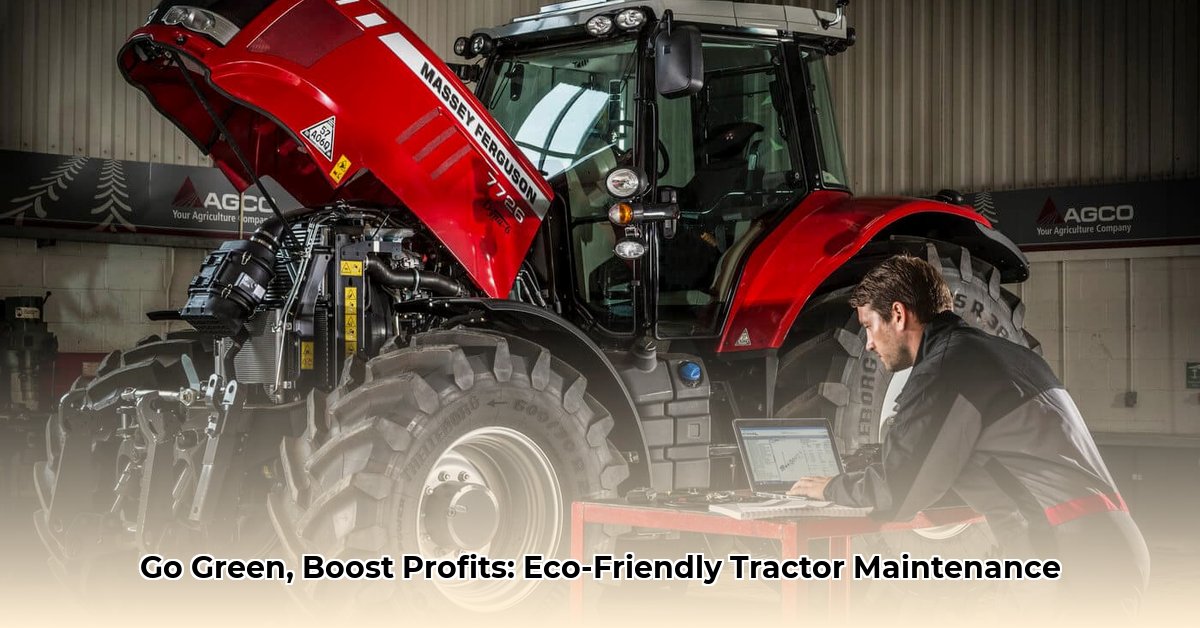
Keeping Your Tractor Running Smoothly: A Practical Guide for Sustainable Farming
Let's be honest: a broken-down tractor means lost revenue and frustrated days. But maintaining peak tractor performance doesn't have to be a struggle. This guide provides step-by-step instructions for efficient and sustainable tractor maintenance, saving you money and minimizing your environmental footprint. We'll cover everything from basic weekly checks to environmentally conscious practices, ensuring your tractor remains a reliable asset for years to come. For additional cleaning supplies, check out these tractor parts cleaners.
Why is Tractor Maintenance Crucial for Sustainable Farming?
Think of your tractor as the heart of your farm. Neglecting regular maintenance is like ignoring a persistent cough – a small issue can escalate into a major, costly crisis. Ignoring your tractor’s needs leads to unexpected breakdowns, reduced harvests, and increased environmental impact. However, regular maintenance is an investment that pays off considerably, saving you money in the long run and contributing to a healthier farming ecosystem.
A Step-by-Step Guide to Eco-Friendly Tractor Maintenance
This practical guide will help you keep your tractor running smoothly and efficiently.
1. Weekly Check-Ups: Your Quick Routine
Dedicate a few minutes each week to a visual inspection of your tractor. This simple routine can prevent major problems.
- Fluids: Check engine oil, coolant, and hydraulic fluid levels. Replenish low levels immediately. Murky or discolored fluids indicate a need for a change.
- Belts and Hoses: Inspect for cracks, fraying, or wear. Damaged components can lead to significant breakdowns.
- Tires: Check for cuts, bulges, and excessive wear. Proper tire pressure is essential for fuel efficiency and preventing damage.
- Unusual Noises or Issues: Listen carefully for unusual sounds and note anything that looks damaged or out of place. Address even minor problems promptly.
2. Fluid Changes: The Heart of Your Tractor's Health
Adhere to your tractor's manual for recommended oil, filter, and fluid change intervals. Using high-quality, eco-friendly lubricants is a smart financial and environmental choice. Remember to dispose of used fluids responsibly, following local guidelines.
3. Air Filters: Ensuring Clean Air for Peak Performance
Clean or replace your air filters regularly (typically every 50 hours of operation, but check your manual). A clogged filter reduces engine performance, wastes fuel, and can cause engine damage. Filter replacement is an inexpensive way to significantly improve fuel economy.
4. Fuel System: Clean Fuel for Optimal Operation
Regularly clean your fuel filters and inspect fuel lines for leaks. Contaminated fuel severely impacts engine performance.
5. Electrical System: Maintaining Power and Safety
Inspect all wiring, lights, and battery connections. Electrical problems can cause significant downtime.
6. Brakes and Steering: Safety First
Regularly check your brakes and steering components. These are critical safety features, ensuring both your safety and the safety of those working around you.
7. Detailed Records: The Power of a Maintenance Logbook
Keep a detailed log of all maintenance activities, including dates, procedures, and parts replaced. This log serves as your tractor's health record, helping to predict future needs and ensure smooth operation.
Sustainable Tractor Maintenance: Farming Responsibly
Sustainable agriculture is a necessity, not just a trend. Incorporate eco-friendly practices into your maintenance routine:
- Biodegradable Lubricants: Use biodegradable lubricants whenever feasible; they're environmentally friendly and just as effective as traditional alternatives.
- Responsible Waste Disposal: Always dispose of used oil and filters properly according to local regulations to protect water sources and soil.
- Fuel Efficiency: Regular maintenance improves fuel economy, reducing your farm's carbon footprint and saving you money.
Predictive Maintenance: Embracing Technological Advancements
Modern technologies like smart sensors and data analytics can predict potential problems before they occur. This proactive approach minimizes downtime and maximizes efficiency. While the initial investment may be higher, long-term savings from avoided repairs and increased productivity quickly outweigh the costs. Dr. Amelia Hernandez, Agricultural Engineer at the University of California, Davis, states, "Predictive maintenance is no longer a luxury; it's a necessity for sustainable and profitable farming."
Calculating ROI & TCO: The Financial Benefits of Preventative Maintenance
While regular maintenance may seem expensive initially, the long-term benefits far outweigh the costs. The cost of preventative maintenance is significantly lower than the expense of major breakdowns, lost productivity, and emergency repairs.
Calculating ROI: (Net Return / Investment Cost) x 100. Net return is the difference between avoided repair costs and preventative maintenance costs.
Total Cost of Ownership (TCO): A holistic approach that considers all costs over the tractor's lifespan, including purchase price, fuel, repairs, maintenance, and depreciation. TCO analysis highlights the long-term financial advantages of preventive maintenance.
Your Role in Sustainable Tractor Maintenance: A Commitment to Success
Your dedication to regular inspections, responsible practices, and detailed record-keeping is essential for sustainable tractor maintenance. You're not just maintaining equipment; you're actively investing in your farm's future and a healthier planet. Your commitment directly contributes to a sustainable and prosperous farming operation.